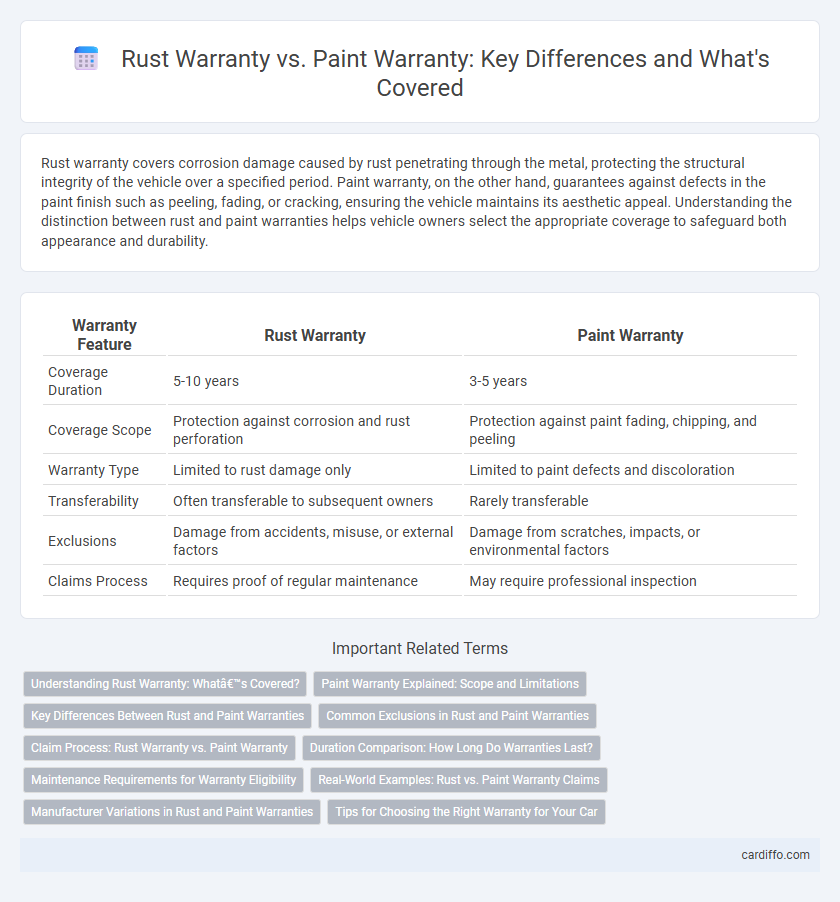Rust warranty covers corrosion damage caused by rust penetrating through the metal, protecting the structural integrity of the vehicle over a specified period. Paint warranty, on the other hand, guarantees against defects in the paint finish such as peeling, fading, or cracking, ensuring the vehicle maintains its aesthetic appeal. Understanding the distinction between rust and paint warranties helps vehicle owners select the appropriate coverage to safeguard both appearance and durability.
Table of Comparison
| Warranty Feature | Rust Warranty | Paint Warranty |
|---|---|---|
| Coverage Duration | 5-10 years | 3-5 years |
| Coverage Scope | Protection against corrosion and rust perforation | Protection against paint fading, chipping, and peeling |
| Warranty Type | Limited to rust damage only | Limited to paint defects and discoloration |
| Transferability | Often transferable to subsequent owners | Rarely transferable |
| Exclusions | Damage from accidents, misuse, or external factors | Damage from scratches, impacts, or environmental factors |
| Claims Process | Requires proof of regular maintenance | May require professional inspection |
Understanding Rust Warranty: What’s Covered?
Rust warranty typically covers perforation or holes caused by corrosion on the vehicle's metal body panels, ensuring repairs or replacements for damage due to rust-through. This warranty excludes surface rust or cosmetic blemishes and usually lasts significantly longer than paint warranties, often up to 12 years or more. Paint warranty, in contrast, focuses on defects like peeling, blistering, or fading of the vehicle's exterior paint finish, typically valid for 3 to 5 years.
Paint Warranty Explained: Scope and Limitations
Paint warranty typically covers defects in the paint finish such as peeling, cracking, or fading caused by manufacturing issues, lasting between 3 to 10 years depending on the manufacturer. It excludes damage from environmental factors like stone chips, accidents, or improper maintenance, which are not covered under standard paint warranties. Understanding the specific terms, coverage duration, and exclusions of a vehicle's paint warranty ensures consumers know their protection scope and limitations.
Key Differences Between Rust and Paint Warranties
Rust warranties typically cover corrosion damage caused by defects in materials or workmanship, ensuring protection against structural deterioration over a specified period. Paint warranties focus on preserving the vehicle's exterior finish, guarding against issues like fading, peeling, or blistering due to manufacturing flaws. Understanding the key differences between these warranties helps consumers know what type of damage is covered and the duration of protection for both rust and paint defects.
Common Exclusions in Rust and Paint Warranties
Rust warranties commonly exclude damage caused by environmental contaminants such as road salt, bird droppings, or acid rain, as well as neglect or improper maintenance leading to corrosion. Paint warranties typically exclude issues resulting from physical damage, such as scratches, chips, or fading due to prolonged sun exposure beyond recommended care. Both warranties often do not cover alterations or repairs performed by unauthorized service providers, which can void coverage for rust or paint defects.
Claim Process: Rust Warranty vs. Paint Warranty
Rust warranty claims typically require detailed inspection reports documenting corrosion beneath the surface, often necessitating photographic evidence and professional assessment to validate the damage. Paint warranty claims usually focus on surface defects such as peeling, bubbling, or fading and may only require visual verification by the dealership or manufacturer. Both warranties have specific timeframes and conditions outlined in the coverage, influencing eligibility and the complexity of the claim process.
Duration Comparison: How Long Do Warranties Last?
Rust warranties typically offer coverage ranging from 5 to 12 years, focusing on corrosion perforation and structural integrity. Paint warranties generally last between 3 and 7 years, covering defects like fading, peeling, or blistering under normal conditions. Understanding these duration differences helps consumers assess long-term protection against environmental and wear-related damages.
Maintenance Requirements for Warranty Eligibility
Rust warranty requires regular inspections and prompt treatment of any surface corrosion, ensuring protective coatings remain intact to prevent rust formation. Paint warranty mandates careful cleaning routines and avoidance of abrasive materials to maintain the paint's protective layer and vibrant finish. Both warranties specify adherence to manufacturer-recommended maintenance schedules to validate coverage and avoid claim denial.
Real-World Examples: Rust vs. Paint Warranty Claims
Rust warranties typically cover corrosion-related damage that penetrates the metal, often lasting up to 5-7 years, as seen in vehicles exposed to harsh winter conditions where salt accelerates rust formation. Paint warranties generally cover defects like fading or peeling, usually offered for around 3 years, with claims filed due to sun damage or chemical stains evident in regions with intense UV exposure. Real-world claims data show rust warranty claims are more frequent in northern climates with heavy road salt use, while paint warranty claims peak in sunny, arid areas prone to surface deterioration.
Manufacturer Variations in Rust and Paint Warranties
Manufacturer variations in rust and paint warranties significantly impact vehicle protection coverage, with rust warranties often extending from 5 years up to a lifetime, while paint warranties typically range between 3 to 7 years. Rust warranties usually cover perforation caused by corrosion but exclude surface rust, whereas paint warranties focus on defects like fading, chipping, and peeling due to manufacturing issues. Understanding these differences helps consumers compare manufacturer offerings and select vehicles with optimal long-term durability against environmental damage.
Tips for Choosing the Right Warranty for Your Car
When selecting a car warranty, prioritize rust warranty coverage for long-term protection against corrosion, especially in regions with harsh winters or salty roads. Paint warranty is essential for preserving the vehicle's aesthetic value, covering damages like fading, peeling, or chipping due to environmental factors. Evaluate your local climate, vehicle use, and ownership duration to choose a warranty that best balances protection against rust damage and paint deterioration.
Rust Warranty vs Paint Warranty Infographic

 cardiffo.com
cardiffo.com